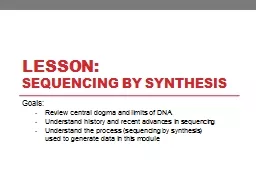

Goals Review central dogma and limits of DNA Understand history and recent advances in sequencing Understand the process sequencing by synthesis used to generate data in this module What is DNA ID: 911369
Download Presentation The PPT/PDF document "Lesson: Sequencing by synthesis" is the property of its rightful owner. Permission is granted to download and print the materials on this web site for personal, non-commercial use only, and to display it on your personal computer provided you do not modify the materials and that you retain all copyright notices contained in the materials. By downloading content from our website, you accept the terms of this agreement.
Slide1
Lesson: Sequencing by synthesis
Goals:
Review central dogma and limits of DNA
Understand history and recent advances in sequencing
Understand the process (sequencing by synthesis) used to generate data in this module
Slide2What is DNA?
10010110
(coding)
to
as
5’
GATTACA
3
’
(DNA)
to
LIFE
2
Slide3The Central Dogma
DNA
5’
GATTACA
3’
3
Responsible for most of the
structure
and
function
of an organism
goes to
protein
Slide4Different ways to represent DNA
4
5’-ATTAGCTAGAC-3’
3D structure
2D chemical structure
Sequence
DNA sequencing
simply means
reading the sequence of the DNA
Slide5Very small yet very big
DNA is tiny
Each letter in the DNA sequence is less than one nanometer
Genomic information is massive
3 BILLION letters in the human genome
LIFE
5
Slide6So what?
What can we do with DNA sequencing?
6
Are the following scenarios “Sci-Fi” or “Reality”?
Slide7Identify whether someone is more or less likely to commit a crime
7
Sci-fi.
Slide8Figure out the identity of ancient human remains
8
Reality.
Slide9Use preserved DNA to re-create extinct plants and animals
9
Sci-fi.
Slide10Use human DNA to create a clone with the same personality
10
Sci-fi.
Slide11Track disease by monitoring toilet waste from airplanes
11
Reality.
Slide12Next-Generation Sequencing makes these advances possible
1 human genome in 13 years
~40 sequencing institutions
$3,000,000,000 per genome
16 human genomes in 3 days
1 sequencing system
$1,000 per genome
1990-2003: Human Genome Project
“Sanger sequencing”
technology
Today“Next-generation sequencing” technology
12
Slide1313
Slide14DNA Sequencing by Synthesis
Bioinformatics Inquiry through Sequencing
Slide15DNA synthesis
Template strand
DNA polymerase
Primer
Nucleotides
ATGAGCTTAGCTA
TACTCG
T
A
C
T
G
G
C
A
T
15
Slide16DNA synthesis
ATGAGCTTAGCTA
TACTCG
T
A
C
T
G
G
C
A
T
16
Slide17DNA synthesis
ATGAGCTTAGCTA
TACTCGAATCGAT
17
Slide18Sequencing By Synthesis
18
Sequence DNA by observing the synthesis of a complimentary strand
MiSeq
sequencer
Slide19INLET
DNA is attached to the surface of a flow cell
OUTLET
19
DNA is fixed in place while various chemicals wash over it
The camera takes pictures of DNA synthesis while it happens
Slide20Make identical copies
Because nucleotides are so small, they are difficult to see, even when attached to fluorescent dyes
T
he sequencer copies the sample sequence to form a large group of identical sequences.
This group is called a
clusterThe fluorescent signal from a cluster is much greater than the fluorescent signal from a single strand
20
Slide21OUTLET
DNA is fixed to the surface of a flow cell
INLET
21
Slide22Fluorescent Dye
A
T
G
C
When excited by a laser, fluorescent dyes emit brightly colored light
Each nucleotide is attached to a unique fluorescent dye
22
Blue
A
Red
T
Green
G
Yellow
C
Slide23Sequencing By Synthesis
K.
Voelkerding
,
et al
, Clinical Chemistry, 2009
23
Slide24Fluorescent Dye
Laser excites fluorophore.
Camera captures color
Each color indicates a specific base
(support.Illumina.com)
24
Slide25Tracking colors
25
The sequencer uses a camera to identify the color of each nucleotide as it gets added
Write the first letter of the color you see:
R
ed
B
lue
Y
ellow or
G
reen
DNA synthesis happens fast and uncontrollable
Slide26Blocking group controls speed
3’-ATGC-5’
5’-TA
x
C
??
26
Deblocker
Slide27Speed can now be controlled
27
Without blocking groups
With blocking groups
Slide28Sequencing by Synthesis
28
Slide29Primer and polymerase attach
29
Slide301. Add nucleotide
30
Slide312. Image fluorescence
31
Slide323. Remove dye
32
Slide33Sequencing by synthesis
33
Slide34Sequencing by synthesis
34
Slide35Sequencing by synthesis
35
Slide36Sequencing by synthesis
36
Slide37Sequencing by synthesis
37
Slide38Sequencing by synthesis
38
Slide39Complete sequence
39
Slide40What the camera sees:
40
Image 1
Image 2
Image 3
Image 4
Image 5
Blue
A
Red
T
Green
G
Yellow
C
G
G
A
C
T
Slide41What the camera sees:
41
Image 1
Image 2
Image 3
Image 4
Image 5
Blue
A
Red
T
Green
G
Yellow
C
G
T
C
G
A
Slide42Modeling Activity
Everyone gets a role:
DNA Polymerase
PrimerSequence complementary of primer
LaserCameraNucleotides of the original sequenceDeblocker
Nucleotides
42
Slide43Image Credits
Applications
Criminal baby: toddlerhalloweencostumes.com
Jurassic world: http://www.jurassicworld.com
/Airplane poop: http://www.wired.com/2015/08/airplane-poop-help-track-global-disease-outbreaks/
43